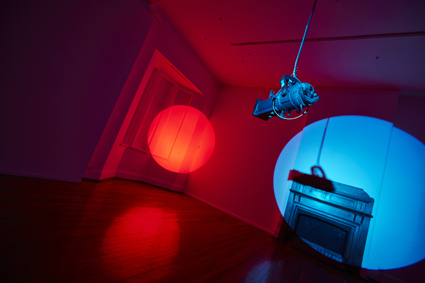 |
Michaela Gleave, A Day is Longer Than a Year photo Jessica Wyld |
Michaela Gleave is an installation artist who has worked with artificial snow, balloons, fog, glitter and water. Her work forms part of the phenomenological turn in installation art that has for the last decade wanted to simulate nature inside the gallery. With only two lights, this installation is a more austere version of these immersive environments, its sharp poetics resembling the clean edges of 1960s minimalism. Yet nature is at play here too, as Gleave created this work out of a residency with the CSIRO’s Astronomy and Space Science Division.
Space research and minimalism have much in common. They share a fascination with the most elemental of forces and shapes. They share a coldness too, as these elements are indifferent to human fate. In Australia, space scientists work with the most distant of subjects, as they process data from the radio telescopes that dot the country. One of the most recent developments in deep space science is the detection of planets that are orbiting other stars.
The technique involves measuring a shift in the spectrum of starlight. A planet will wobble this spectrum and cause a star to become more red or blue. These are the colours that Gleave uses in her installation, their momentum shifting the shape of the spotlights moving on the walls.
It is as if we are at the centre of some deep space simulation, as Gleave conjures associations with the movement of planets and suns with the simplest of means. Yet the austere beauty of the work is also cursed by the kind of anthropocentrism that haunts space science. The attempt to find extra-solar planets, like the search for water on Mars, is deeply invested with the hope of finding another Earth in deep space. So too Gleave’s cosmic theatre returns us to ourselves, as we are trapped in the middle of the room, for fear of moving and throwing a shadow onto the orbit of lights. The installation turns into a kind of dark cinema that makes the space claustrophobic.
So it is that the cosmos, proving to be so indifferent to us, makes a troubling subject for art. It awes and repulses at the same time, fascinates and horrifies in its mathematical and glorious perfection.
This visitor wanted both something more and something less from this installation, for a sound to accompany the light, or a revolving chair to simulate an astronaut’s experience of the stars. Yet such comforts would move us beyond the subject of Gleave’s installation, which is the inherent austerity of space and time, and the beauty of light.
Michaela Gleave, A Day Is Longer Than A Year, Fremantle Arts Centre, Perth, 8 June–21 July
RealTime issue #116 Aug-Sept 2013 pg. 53
© Darren Jorgensen; for permission to reproduce apply to [email protected]








 back
back